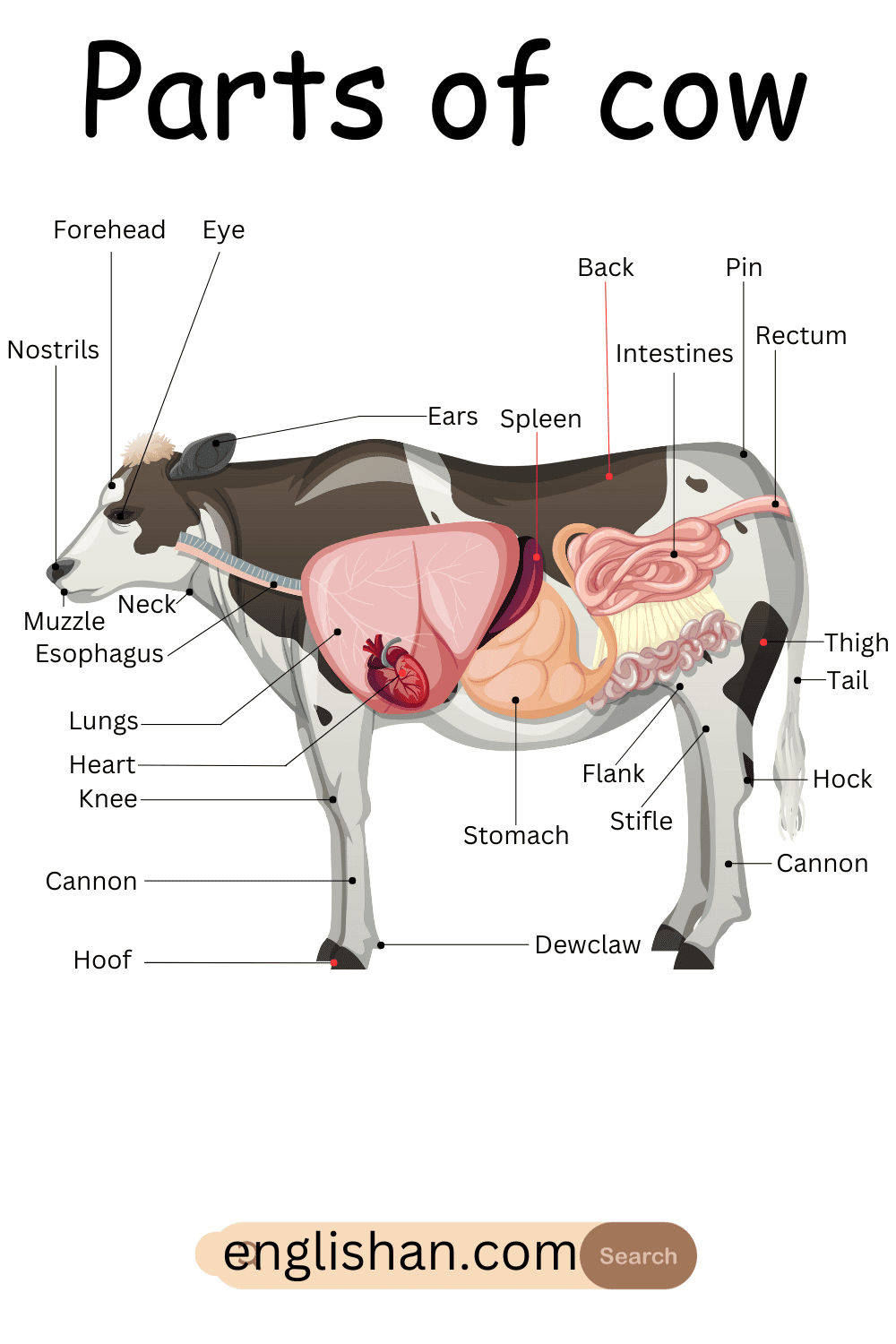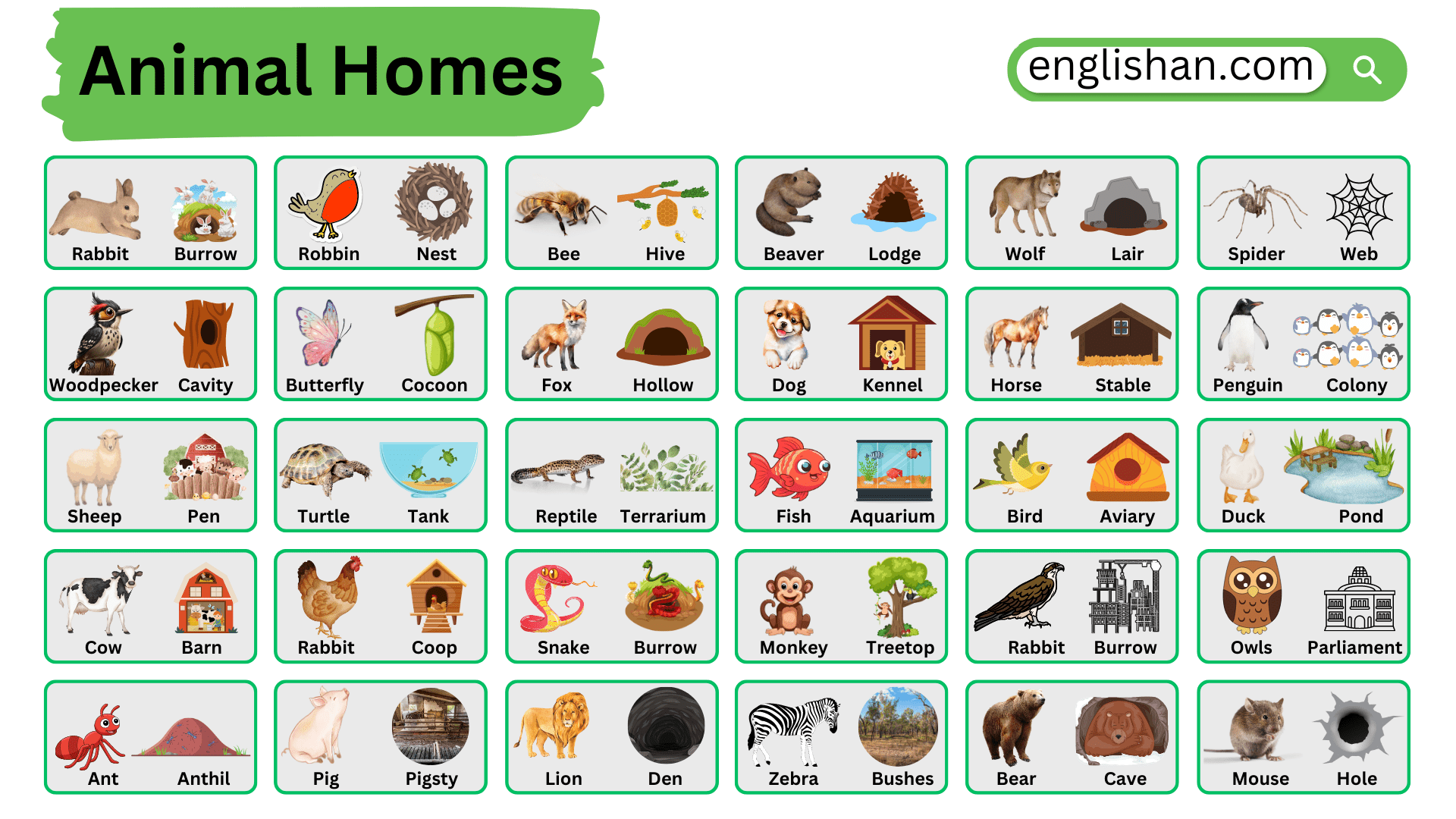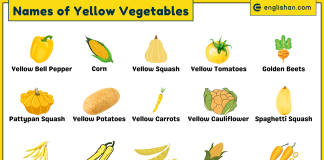Contents
In this blog post, you will learn the different parts of a cow in English. Understanding these names will help you describe cows clearly and improve your vocabulary. Whether you are talking about farm animals or studying for school, knowing these terms is useful. This will also help you recognize the body parts of other animals with similar features.
To learn more vocabulary on different topics, visit our Vocabulary Category.
Types of Cow
Cattle come in various breeds, each with its own unique characteristics, such as size, coat color, temperament, and production traits. Here are some common types of cows, categorized by their primary use:
1. Dairy Cows:
- Holstein: Known for high milk production, black and white in color.
- Jersey: Smaller in size, fawn in color, and valued for high butterfat content in milk.
- Guernsey: Known for rich milk with a golden color.
- Ayrshire: Red and white breed with good milk production.
2. Beef Cows:
- Angus: Black in color, known for marbled beef and good maternal qualities.
- Hereford: Red with a white face, adaptable to various climates.
- Charolais: White or cream-colored breed, known for rapid growth and large size.
- Limousin: Red or black, muscular breed with high meat yield.
3. Dual-Purpose Cows:
- Simmental: Dual-purpose breed for both beef and milk production.
- Shorthorn: Known for both milk and beef production, with red, white, or roan coloration.
4. Draft Cows:
- Belgian Blue: Blue-gray in color, large and heavily muscled; primarily used for meat production.
- Piedmontese: Originating from Italy, known for lean meat and high muscle yield.
5. Miniature Cows:
- Miniature Zebu: Smaller-sized cattle with a hump on the back, originally from India.
- Dexter: A small, dual-purpose breed with a friendly disposition.
6. Specialized Breeds:
- Highland Cattle: Recognized for their long, shaggy hair and adaptability to harsh climates.
- Texas Longhorn: Known for distinctive long horns and hardiness.
7. Crossbreeds:
- Brangus: Cross between Angus and Brahman, known for heat tolerance and good beef quality.
- Santa Gertrudis: Cross between Shorthorn and Brahman, developed for both beef and heat resistance.
These are just a few examples, and there are many more cattle breeds with distinct characteristics. The choice of breed often depends on the intended purpose, environmental conditions, and management goals of the livestock operation.

Parts of Cow
A cow is a large mammal that has various parts, each serving specific functions. Here are some key parts of a cow:
Forehead: The front part of the head above the eyes.
Eye: The organ used for seeing.
Ear: External organ for hearing.
Nostrils: Openings in the nose for breathing.
Muzzle: The nose and mouth area of the face.
Neck: The part of the body connecting the head to the shoulders.
Esophagus: The tube that carries food from the mouth to the stomach.
Dewlap: Loose skin under the neck.
Lungs: Organs for breathing and oxygen exchange.
Heart: The muscular organ that pumps blood.
Knee: Joint in the middle of the leg, similar to a human’s knee.
Cannon: The lower part of the leg between the knee and the hoof.
Hoof: The hard covering on the bottom of the foot.
Spleen: Organ involved in blood filtration.
Back: The upper part of the body along the spine.
Pin: The hip area on each side of the tail.
Rectum: The end of the digestive tract where waste is expelled.
Intestines: The tube-shaped organs where digestion and nutrient absorption occur.
Thigh: The upper part of the hind leg.
Tail: The extension of the spine at the back of the cow.
Hock: Joint in the hind leg, similar to an ankle.
Cannon: (Repeated) The lower part of the leg between the knee and the hoof.
Flank: The side of the body between the ribs and the hip.
Stifle: Joint in the hind leg, similar to the human knee.
Dewclaw: A vestigial, often nonfunctional, claw or toe.
These parts collectively contribute to the cow’s anatomy, enabling it to perform essential functions like digestion, movement, and sensory perception.
Health Care
Cow health care involves providing a balanced diet, clean water, and shelter. Regular veterinary check-ups and vaccinations prevent diseases. Parasite control, reproductive health management, and foot care are essential. Biosecurity measures and hygiene reduce the risk of infections. Enriching the environment and having an emergency plan contribute to overall well-being.
Medication Mistakes
In cattle farming, medication mistakes can harm animal health and food safety. To prevent errors:
- Follow precise dosages and veterinary prescriptions.
- Check and discard expired medications.
- Keep accurate records and follow withdrawal periods.
- Clearly identify animals before medication.
- Consider food safety implications.
- Monitor for allergic reactions and seek prompt veterinary assistance.
- Use proper injection techniques and disposal procedures.
- Finish full treatment courses to prevent resistance.
- Quarantine new animals and follow environmental guidelines.
- Always consult with a veterinarian for proper guidance.
Vaccination Process & Importance of Vaccination
Vaccination is a crucial aspect of maintaining the health and well-being of cattle, including cows. The vaccination process involves administering vaccines to protect animals from specific diseases. Here are key points regarding the vaccination process and its importance for cows:
Vaccination Process for Cows:
1. Identify Target Diseases:
- Different regions and farming conditions may require specific vaccines. Identify the prevalent diseases in the area and those that pose a risk to the herd.
2. Vaccine Selection:
- Choose vaccines that provide protection against common and potential diseases. Consult with a veterinarian to determine the appropriate vaccines for your herd.
3. Vaccination Schedule:
- Establish a vaccination schedule based on the age, reproductive status, and local disease patterns of the cows. Some vaccines may require annual boosters, while others may be administered more frequently.
4. Proper Storage:
- Follow the recommended storage conditions for vaccines. Improper storage can compromise the efficacy of the vaccines.
5. Administration:
- Administer vaccines according to the manufacturer’s instructions. Some vaccines may be given through injection, while others can be administered orally or intranasally.
6. Record Keeping:
- Maintain accurate records of vaccinations, including the date, type of vaccine, and individual identification of the vaccinated cows. This helps in tracking the vaccination status of each animal.
7. Follow-Up Boosters:
- Some vaccines require initial and booster doses. Ensure that all follow-up doses are administered on schedule to maintain immunity.
8. Isolation and Monitoring:
- Quarantine new animals before introducing them to the herd, and monitor for any signs of adverse reactions post-vaccination.
Importance of Vaccination for Cows:
1. Disease Prevention:
- Vaccination helps prevent the spread of infectious diseases within the herd. Common diseases include bovine viral diarrhea (BVD), infectious bovine rhinotracheitis (IBR), and leptospirosis.
2. Herd Health and Productivity:
- Healthy cows are more productive and have better reproductive performance. Vaccination contributes to overall herd health and can improve reproductive outcomes.
3. Economic Benefits:
- Investing in vaccinations can save on veterinary costs associated with treating sick animals. It also reduces losses in productivity and potential economic losses due to disease outbreaks.
4. Zoonotic Disease Prevention:
- Some diseases affecting cows can also pose a risk to human health. Vaccination helps prevent zoonotic diseases, protecting both animals and farmers.
5. Compliance with Regulations:
- In some regions, certain vaccinations may be mandatory to comply with regulatory requirements and maintain a healthy livestock population.
6. Herd Immunity:
- Vaccination contributes to herd immunity, reducing the overall prevalence of diseases within the community of animals.
Always consult with a veterinarian to tailor a vaccination program to the specific needs of your herd, taking into account local disease prevalence, herd characteristics, and management practices.
Quiz:
FAQs:
Q1. What are the main parts of a cow’s digestive system?
The main parts of a cow’s digestive system include the mouth, esophagus, stomach (rumen, reticulum, omasum, and abomasum), small intestine, and large intestine.
Q2. What is the purpose of the rumen in a cow?
The rumen is the largest compartment of the stomach and is responsible for the fermentation of feed, breaking down complex plant materials through microbial action.
Q3. Where is the udder located on a cow?
The udder is located on the underside of the cow and is the mammary gland responsible for producing and secreting milk.
Q4. What are the primary functions of a cow’s horns?
Horns can serve various purposes, including defense, establishing social hierarchy, and cooling the body by promoting heat dissipation.
Q5. How many stomachs does a cow have?
Cows have four stomach compartments: rumen, reticulum, omasum, and abomasum.
Q6. What is the purpose of the dewclaw in cows?
The dewclaw is a vestigial digit located higher up on the leg, and its function is not well-defined. In some cases, it may be removed during dehorning.
Q7. Why are cows often dehorned, and how is it done?
Dehorning is often done to reduce the risk of injuries and improve handling safety. It involves removing or blunting the horns, and methods include sawing, gouging, or chemical cauterization.
You May Also Like






